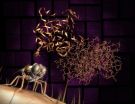(Press-News.org) Researchers at the Douglas Mental Health University Institute, have discovered a new genetic process that could one day provide a novel target for the treatment of neurodevelopmental disorders, such as intellectual disability and autism.
The research study, which appears in the December issue of the American Journal of Human Genetics, was led by Carl Ernst, a Douglas Institute researcher, an assistant professor in McGill's Department of Psychiatry and a Canada Research Chair in Psychiatric Genetics. Ernst and his colleagues found that genetic mutations that negatively affect brain development can occur in a gene family of previously unknown function in the human genome.
According to the World Health Organization, neurodevelopmental disorders affect one in six children in industrialized countries. Impairing the growth and development of the brain or central nervous system, neurodevelopmental disorders encompass a broad range of conditions, including developmental delay, autism spectrum disorders and cerebral palsy. People with neurodevelopmental disorders can experience difficulties with language, speech, learning, behaviour, motor skills and memory.
Mutations in genes are thought to underlie many neurodevelopmental disorders, but all genes important for brain development found to date are in a single pathway. Genes are coded in DNA that gives way to RNA, which gives way to protein. Proteins form the functional unit of the body and are the major players in all biological activity. Prior to the current study, all genetic mutations important for neurodevelopmental disorders, occured in genes that make protein.
The work of Ernst and his research team identified an important shortcut in the process of making functional molecules for brain development. By sequencing the genomes of 200 people with neurodevelopmental disorders and chromosomal abnormalities, and comparing the results to more than 15,000 control samples, the researchers made a surprising discovery: some individuals had mutations in a gene that did not make protein.
"Our discovery tells us that mutations in genes that code only for RNA and do not make protein can have a functional impact and lead to neurodevelopmental abnormalities," Ernst says. "In previous studies of brain development, RNA was just considered a middle player – one that only served as a template for the production of proteins."
By opening up a new area of study involving RNA, Ernst aims to advance understanding of the underlying causes of neurodevelopmental disorders. "We hope to shine a new light on how the brain develops," he says.
### END
Researchers find new genetic pathway behind neurodevelopmental disorders
2012-12-06
ELSE PRESS RELEASES FROM THIS DATE:
Closer look at consumers' gazes
2012-12-06
Montreal, December 6, 2012 – Rows of new toys, endless racks of sweaters on clothing store shelves, long lines of books arranged in the bestsellers section at the bookstore. From mall displays to boutique exhibits, long lines of horizontally arranged products are the norm when it comes to the holiday shopping experience.
But how does a product's placement on the storeroom shelf influence which one a consumer ultimately chooses? It turns out that the shopper's eye has a very central focus.
"Consumers are more likely to purchase products placed in the middle of a display ...
Prenatal tests more informative using microarray technology, find GW researchers
2012-12-06
WASHINGTON – A new method for detecting abnormalities in unborn children is providing physicians with more information to analyze the results than conventional, microscopic testing, according to two George Washington University researchers.
Elizabeth Thom, research professor of epidemiology and biostatistics, and Julia Zachary, senior research scientist, are co-authors of the lead article appearing in the current issue of the New England Journal of Medicine showing that microarray technology provides a more comprehensive result from genetic testing during prenatal care ...
UT MD Anderson study finds link between statins and improved survival in inflammatory breast cancer
2012-12-06
HOUSTON - Researchers from The University of Texas MD Anderson Cancer Center found statins, the commonly used drug to lower cholesterol, improved progression-free survival in patients with inflammatory breast cancer (IBC).
The retrospective study was presented today in a poster discussion at the 2012 CTRC-AACR San Antonio Breast Cancer Symposium and follows a previously reported Danish study indicating there is some evidence to suggest the anti-inflammatory properties of statins could reduce the risk of breast cancer recurrence. Still, the overall effects of statins have ...
Insect-eating bat outperforms nectar specialist as pollinator of cactus flowers
2012-12-06
SANTA CRUZ, CA--Of the two bat species known to visit the flowers of the cardon cactus in Baja California, one depends entirely on nectar and is highly specialized to feed from the flowers, which are adapted for pollination by bats. The other is an insect-eating bat best known for its ability to hear the footsteps of large insects and scorpions and capture them on the ground.
In a surprising result, scientists at the University of California, Santa Cruz, have found that the insect-eating pallid bat is a more effective pollinator of the cactus flowers than the nectar-feeding ...
Tamoxifen trial should prompt breast cancer patients to reconsider treatment options
2012-12-06
MAYWOOD, Il. - A groundbreaking clinical trial involving the breast cancer drug tamoxifen should prompt certain breast cancer patients to reconsider their treatment options, according to Loyola University Medical Center breast cancer specialist Dr. Kathy Albain.
The trial is called ATLAS (Adjuvant Tamoxifen Longer Against Shorter). It included women with estrogen receptor-positive breast cancer that had not spread to distant organs. Women who took tamoxifen for 10 years had a lower risk of recurrence and lower mortality rate than women who took the drug for 5 years, ...
Fit kids finish first in the classroom
2012-12-06
EAST LANSING, Mich. — Fit kids aren't only first picked for kickball. New research from Michigan State University shows middle school students in the best physical shape outscore their classmates on standardized tests and take home better report cards.
Published in the Journal of Sports Medicine and Physical Fitness, it's the first study linking children's fitness to both improved scores on objective tests and better grades, which rely on subjective decisions by teachers.
The study also is among the first to examine how academic performance relates to all aspects of ...
Eating fewer, larger meals may prove healthier for obese women
2012-12-06
COLUMBIA, Mo. – Media articles and nutritionists alike have perpetuated the idea that for healthy metabolisms individuals should consume small meals multiple times a day. However, new research conducted at the University of Missouri suggests all-day snacking might not be as beneficial as previously thought, especially for obese women.
"Our data suggests that, for obese women, eating fewer, bigger meals may be more advantageous metabolically compared to eating smaller, more frequent meals throughout the day," said the study's lead author, Tim Heden, a doctoral student ...
Fire and ice: Wildfires darkening Greenland snowpack, increasing melting
2012-12-06
SAN FRANCISCO—Satellite observations have revealed the first direct evidence of smoke from Arctic wildfires drifting over the Greenland ice sheet, tarnishing the ice with soot and making it more likely to melt under the sun.
At the American Geophysical Union meeting this week, an Ohio State University researcher presented images from NASA's Cloud-Aerosol Lidar and Infrared Pathfinder Satellite Observation (CALIPSO) satellite, which captured smoke from Arctic fires billowing out over Greenland during the summer of 2012.
Jason Box, associate professor of geography at ...
Georgia State physicist, international researchers discover fastest light-driven process
2012-12-06
A discovery that promises transistors – the fundamental part of all modern electronics – controlled by laser pulses that will be 10,000 faster than today's fastest transistors has been made by a Georgia State University professor and international researchers.
Professor of Physics Mark Stockman worked with Professor Vadym Apalkov of Georgia State and a group led by Ferenc Krausz at the prestigious Max Planck Institute for Quantum Optics and other well-known German institutions.
There are three basic types of solids: metals, semiconductors, used in today's transistors, ...
X-ray laser helps slay parasite that causes sleeping sickness
2012-12-06
An international team of scientists, using the world's most powerful X-ray laser, has revealed the three dimensional structure of a key enzyme that enables the single-celled parasite that causes African trypanosomiasis (or sleeping sickness) in humans.
With the elucidation of the 3D structure of the cathepsin B enzyme, it will be possible to design new drugs to inhibit the parasite (Trypanosoma brucei) that causes sleeping sickness, leaving the infected human unharmed.
The research team, including several ASU scientists, is led by the German Electron Synchrotron (DESY) ...


